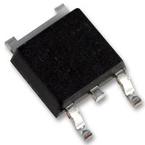下载

© Semiconductor Components Industries, LLC, 2007
January, 2007 − Rev. 2
1 Publication Order Number:
AND8247/D
AND8247/D
Application Note for a 5.0
to 6.5 W POE DC to DC
Converter
Prepared by: Frank Cathell
ON Semiconductor
INTRODUCTION
A solution to one aspect of Power Over Ethernet (POE) is
presented here utilizing the ON Semiconductor NCP1031
series of monolithic, high voltage switching regulators with
internal MOSFET. The application note provides details for
constructing an inexpensive, high efficiency, 5.0 V DC
power supply with a power output of 5.0 to 6.5 W, (output
power is conversion mode dependent — see DC to DC
Converter Operation description below). The associated
input circuitry for responding to POE detection and
classification protocol is also included. ON Semiconductor
also can provide a demonstration PC board with this
circuitry upon request.
POE Background
As a result of IEEE Standard 802.3AF, it is now possible
to inject DC power through Ethernet data transmission lines
to power Ethernet communication devices as long as the end
power requirement is less than 13 W. The parametric details
of DC power transmission and the associated terminology is
outlined in this IEEE document. POE consists of two power
entities: Power Sourcing Equipment (PSE) and Powered
Devices (PDs). The PSEs typically provides 48 Vdc
nominal to the LAN cables while the PDs are small DC−DC
converters at the load end of the cables which transform the
48 V to logic levels such as 5.0 Vdc or 3.3 Vdc or both, to
power the communications equipment. The PDs should be
able to operate with a maximum average input power of
12.95 W, and should be able to tolerate an input voltage
range of 36 to 57 Vdc. In addition, a certain “protocol” is
required in which the PD is detected (Signature Mode) and
then classified (Classification Mode) according to its
maximum power level.
Signature Detection: The upstream PSE equipment detects
the PD by injecting two different voltages between 2.8 and
10 Vdc into the PD input terminals. If the detected impedance
of the PD as measured by the V/I slope is above 23.7 KW, and
below 26.25 KW, the PD is considered present. If the
impedance is less than 15 K, or greater than 33 K, the PD is
considered not present, and no further voltage will be applied.
Classification Mode: To classify the PD according to its
intended power level, the PSE will again source a voltage
between 14.5 and 20.5 Vdc to the PD. The classification is
determined by the current drawn by the PD upon application
of this voltage, and is summarized in the following table:
Class P
min
P
max
I
class
min
I
class
max
R
class
(R4)
0 0.44 W 12.95 W 0 mA 4.0 mA Open
1 0.44 W 3.84 W 9.0 mA 12 mA
217 W
2 3.84 W 6.49 W 17 mA 20 mA
135 W
3 6.49 W 12.95 W 26 mA 30 mA
91 W
4 TBD TBD 36 mA 44 mA
62 W
Note that from the 4
th
and 5
th
columns on the table, that the current drawn from the PSE falls between the I
class
minimum and maximum
values for a given power classification. The last column is the value of the resistor (R4) required for classification in the circuit described by
this application note.
APPLICATION NOTE
http://onsemi.com








